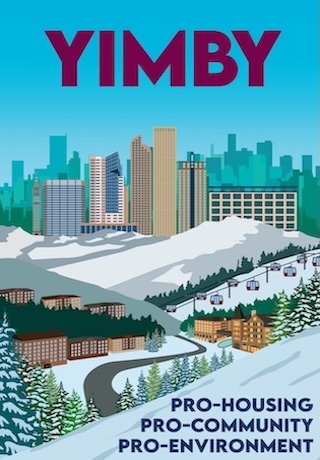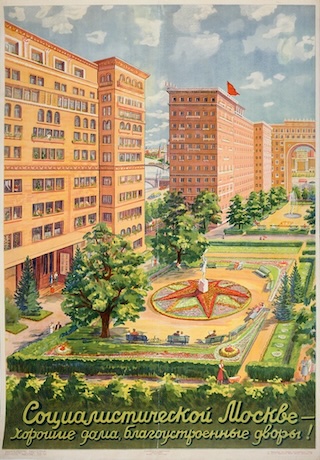Californians are being subjected to some of the worst tyrannies found in the former Soviet Union, according to Los Angeles attorney Chris LeGras. His recent articles, California Tyranny Part 1 and Part 2, show that efforts to build high-density housing in cities is harming people and the neighborhoods they live in, all under the name of YIMBY.
See any similarities?
YIMBY advocates “could not care less about housing affordability, much less about quality of life,” says LeGras. Instead, they want dense housing and revile single-family housing. They claim that advocates of single-family housing are racists, even though 16 million Latinos and 2.2 million blacks live in their own homes in California, and millions more live in single-family homes that they rent.
In fact, it is YIMBYs and the Progressives they represent who are the racists. “Over the last half century, at the very moment in history when nonwhites, and especially Blacks, were finally able to start to realize the American Dream for themselves, lawmakers in California were dismantling the very institutions necessary for them to do so,” argues LeGras. “Even as the state’s population grew from 23.7 million in 1980 to 39.8 million in 2022, we stopped building the most important kind of housing: Starter homes.”
LeGras mistakenly blames the YIMBY movement on “rapacious developers.” In fact, developers want to develop what people want to buy, which means they would rather develop single-family homes than chase after subsidies to make mid-rise and high-rise apartments pencil out. If the state will only let them build apartments, they will build apartments, but they aren’t the real problem. The real YIMBY backers are planners and politicians who adhere to the principles of Compact City, a 1974 book that in turn was partly inspired by the principles of the 1965 book, The Ideal Communist City.
Still, LeGras’ main point remains true: Americans (and most everyone else) prefer to live in single-family homes. By tearing down single-family homes to make room for mid-rise and high-rise apartments, YIMBYs are working counter to that preference, a reality made worse by the fact that mid-rise and high-rise housing costs a lot more than single-family homes.
LeGras is particularly incensed by Senate Bill 79, which is currently making its way through the California legislature promoted by the same people who sponsored Senate Bill 9 in 2021, which abolished single-family zoning. That law required that cities allow four homes on every lot that now has one, and advocates argued that replacing some single-family homes with four-plexes wouldn’t change the character of neighborhoods.
However, SP 79 makes it clear that they aren’t satisfied with four-plexes. The new bill would require cities to rezone all land within a half-mile of rail transit stops and a quarter-mile of many bus stops for multi-story transit-oriented developments. While that sounds like many neighborhoods would remain safe from such changes, LeGras observes that Los Angeles Metro has already re-routed some of its bus routes for the express purpose of making more neighborhoods eligible for transit-oriented development incentives.
YIMBYism has a new ally in the form of the so-called Abundance movement, which seeks to remove the regulatory restrictions that have prevented California from building housing and other infrastructure to support the population growth it enjoyed between 1980 and today. Unfortunately, the Abundance people appear to have the same blinders as the YIMBYists: they want more abundant dense housing, but not single-family housing; they want more construction of high-speed rail and rail transit, but not highways. Ultimately, both the YIMBY and the Abundance movements seek to control how Americans live, and that’s un-American.










A McMansion is not a starter home.
Fact is we wish to accommodate more housing we need more turn century type housing. More cape cods, more bungalows, more ranchers, more shotguns.
These homes worked for a century and stood for a century….
The average US home has 50% more space than it did in 1970, so their volume has grown over 300% thus the amount of energy to heat and cool these homes has grown hugely despite the vast improvements in energy efficiency of air conditioning and heating systems. Passive solar design does not involve any new technology. In fact, it has been around for thousands of years, and even predates the use of glass windows. For most of human history, buildings were adapted to the local climate through a consideration of their location, orientation and shape, as well as the appropriate building materials. This resulted in many vernacular building styles in different parts of the world designed withstand climate.
https://krisdedecker.typepad.com/.a/6a00e0099229e8883301630241ba7b970d-pi
Where as the great defect of the McMansion is it’s lack of climate redundancy. In humid climates mcmansions choice of building materials namely engineered wood products does poorly in moist amd is prone rot amd mold if not constant state of dehumidication. In hot dry climates their insulation value is minute so air conditioner runs 12-18 hours daily. In humid regions ot runs 24/7.
Where as the great advantage of homes designs before advent modern climate control the architects and designers already knew about the climate.
For three decades, I’ve worked for a company that built starter homes in the San Joaquin Valley, creating affordable housing options for first-time buyers. It was a rewarding job—both profitable for the company and personally fulfilling, especially when I met people thrilled to learn I helped build their first home. Thirty years ago, starter home communities averaged 4 to 6 lots per acre, but today, densities have skyrocketed to 14 to 20 lots per acre due to shrinking land availability and rising costs. State regulations have effectively killed that original market. Zoning laws have slashed available land by 80% or more, driving up prices dramatically—property zoned for single-family homes now costs $200,000 per acre, while adjacent agricultural land sits at just $20,000 per acre. Before construction even begins, permits alone cost at least $100,000 per home. On top of that, energy efficiency & climate related building code mandates add $20,000 to $30,000 per unit, fire sprinkler requirements tack on $3,000 to $5,000, and the solar mandate contributes another $15,000. When you add it all up, California’s rules make starter homes financially unfeasible, forcing builders to cater exclusively to middle- and upper-class buyers.
The only remaining affordable options are in rural, unincorporated areas with cheaper land and lower permitting costs. But even there, growth is stifled by inadequate infrastructure, and upgrading it is a nightmare. Prevailing wage and union rules inflate public infrastructure projects to three times the cost of private ones, while approvals drag on for years.
In short, politicians have crushed the California dream, turning what was once an attainable milestone—buying a first home—into a privilege reserved for the wealthy.
No one wants to live in an apartment building, that’s why we need to keep them illegal. Otherwise, people might live in them.
Urbanists are in the closet NIMBYs
Google park slope civic group or, Greenwich village. These groups fight for historic preservation, of brownstone and six story low rises against demolition for 20-30 story condos.
Even people who live within urban density, don’t want more of it.
“Even people who live within urban density, don’t want more of it.”
And yet for some reason, more people want to live there than currently do.